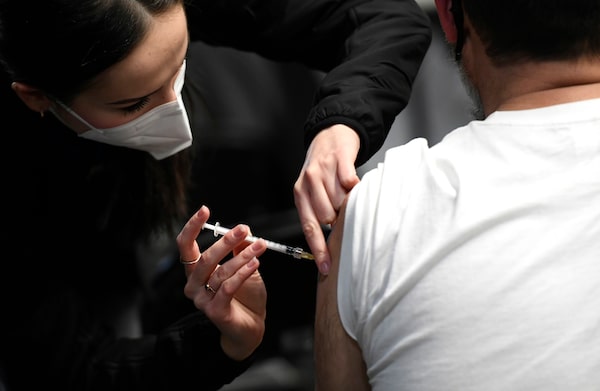
A medical student delivers a COVID-19 booster shots at a pop up vaccine clinic in Ottawa, on Dec. 20, 2021.Justin Tang/The Canadian Press
Question: Will this fall’s COVID-19 vaccine booster shot protect me from the new variant EG.5 rapidly spreading across Canada?
Answer: The general consensus among medical experts is that EG.5 is closely related to the version of the virus targeted by the vaccine, so it should still work well.
It’s true that it’s challenging to create an effective COVID-19 booster shot. Work on an updated vaccine usually begins months before it is rolled out to the public. In the meantime, the virus continues to mutate and evolve, making it a moving target.
What you need to know is that COVID-19 vaccines train the immune system to recognize the spike protein, a knobby protrusion that the virus uses to invade cells. The vaccine essentially stimulates the production of antibodies that latch onto the spike protein and block the virus.
But as the virus mutates, the shape of the spike protein can change. That makes it more difficult for antibodies to do their job. As a result, COVID-19 vaccines need to be updated to deal with the latest version of the virus in circulation.
So how do manufacturers decide what to put into their vaccines?
The formulation of a vaccine involves “a collective decision-making process” that includes both government regulatory agencies as well as technical advisory groups from around the world, said Shehzad Iqbal, the Canadian medical director for Moderna, a leading manufacturer of COVID-19 vaccines.
Earlier this year, the World Health Organization recommended that the next vaccine should target an Omicron descendant lineage called XBB.1 or its close relatives. And then in June, a U.S. Food and Administration advisory committee endorsed XBB.1.5 as the target which, at the time, was the dominant form of the virus in the United States.
Now all the major COVID-19 vaccine manufacturers have made XBB.1.5′s spike protein their target.
It is worth noting that EG.5 is closely rated to XBB.1.5. “They are in the same family. EG.5 is actually a derivative of the XBB lineage,” said Angela Rasmussen, a virologist at the University of Saskatchewan.
“These two viruses are very, very similar from your immune system’s perspective. So there should be a good amount of protection from the XBB booster towards EG.5,” she added.
In fact, preliminary research for this fall’s vaccine supports that assumption.
Dr. Iqbal said that Moderna uses a “mouse-model system” to initially test the effectiveness of its vaccines against new variants. The mice are inoculated and then researchers carry out tests to see if the antibodies generated by the vaccine can block an infection.
The company also has a clinical trial program which follows people who have received COVID-19 vaccines. As part of this program, volunteers in the United States were given a booster shot that targets the XBB.1.5 variant. Blood samples, which contain the resulting antibodies, were collected for future studies.
“We have blood samples sitting in the freezer,” explained Dr. Iqbal. “So we pull out those samples and test them against new variants that come along.”
According to preliminary clinical trial data released last week by Moderna, the company’s vaccine generated “a significant boost in neutralizing antibodies against EG.5.”
In a telephone interview, Dr. Iqbal added that the vaccine produces a “very similar antibody response” to both XBB.1.5 and EG.5.
“This is giving us a degree of confidence that you are going to get a potentially protective response” from Moderna’s fall booster shot which is created using relatively new messenger-RNA vaccine technology, he said.
The other major manufacturer of messenger-RNA vaccines – Pfizer-BioNTech – did not respond to requests for an interview.
Experts are hoping that a successful booster shot program will help ease pressures on the health care system during the busy cold and flu season.
“Right now our thought is that the protection will be fairly good,” said Fahad Razak, an associate professor of medicine at the University of Toronto.
But, of course, there is always the possibility that a new variant could emerge in the coming months “and the vaccines are not going to be as effective against it,” noted Dr. Rasmussen.
Yet even if that happens, vaccines will likely be able to provide at least some degree of defence.
“We haven’t seen a situation where you get really good protection against one variant and zero protection against the next variant,” said Dr. Razak, who is also an internal medicine physician at St. Michael’s Hospital in Toronto.
“Rather, you get an eroding level of protection.”
That suggests the vaccines may not be able stop a new immune evading-variant from causing an infection. But they will likely still be able to prevent severe disease.
“We expect the vaccines will help keep people out of the hospital – and keep people out of the morgue,” said Dr. Rasmussen.
Paul Taylor is a former Patient Navigation Adviser at Sunnybrook Health Sciences Centre and former health editor of The Globe and Mail.